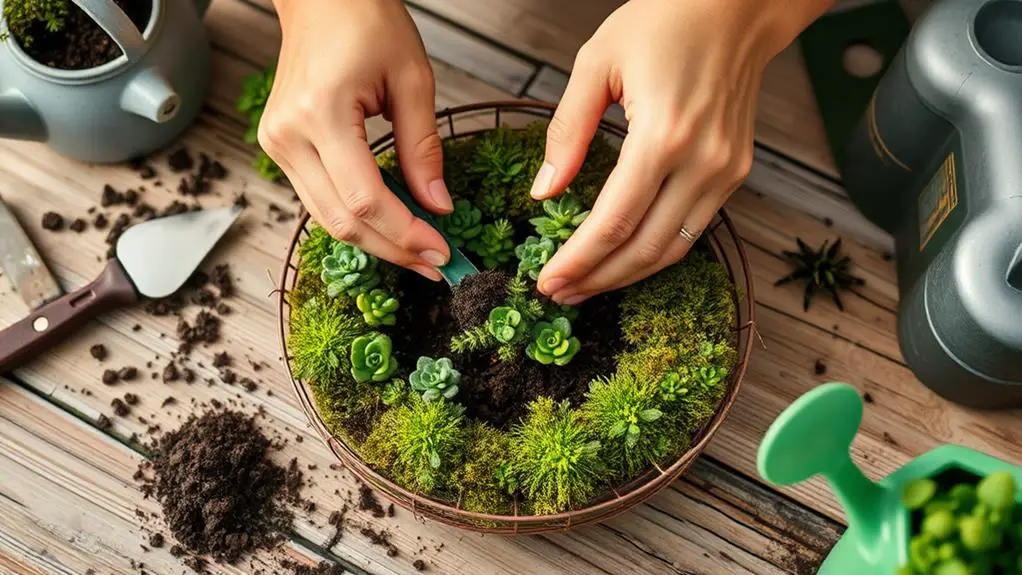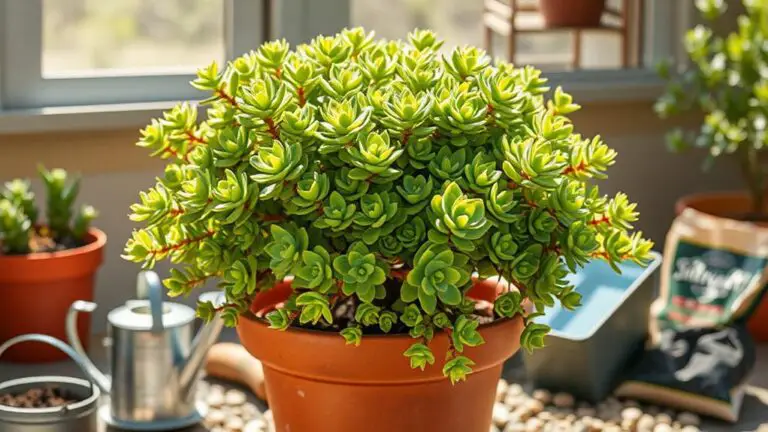Make a Living Succulent Wreath: A Step-by-Step Guide
Creating a living succulent wreath is a delightful way to incorporate natural elements into your home décor. You'll start by gathering essential materials, including a sphagnum moss wreath frame and a variety of succulent cuttings. Once you've soaked the moss and chosen your frame, the real fun begins with arranging the succulents. But how do you guarantee the cuttings root properly and thrive for months? Let's explore the detailed steps and tips that will help you craft a wreath that not only looks stunning but also lasts.
Materials Needed

To create a living succulent wreath, you'll need to gather a few essential materials. Start with a 15-inch sphagnum moss wreath form. This size is perfect for holding around 200 succulent cuttings, giving you plenty of room to create a beautiful and lush wreath.
Next, gather your succulent cuttings. Aim for about 200, mixing various colors, textures, and sizes. This will make your wreath visually appealing and interesting.
You'll also need scissors to trim the cuttings and shape any floral wire you might use during the assembly.
Floral pins, also known as greening pins, are crucial for securing the succulent cuttings into the sphagnum moss wreath. They guarantee that the cuttings stay firmly in place as they begin to root.
If you want to give your cuttings a little extra help, consider using a rooting powder to promote root growth.
Choosing the Wreath Frame

When it comes to choosing the wreath frame for your living succulent wreath, a premade sphagnum moss wreath frame is highly recommended for its convenience and time-saving benefits. This type of frame simplifies the assembly process and guarantees that your succulents have a good start.
Opting for a 15" wreath frame is ideal because it provides ample space to accommodate approximately 200 succulent cuttings. This size allows you to create a lush and full wreath that will be visually stunning.
Here are three reasons to choose a premade sphagnum moss wreath frame:
- Convenience: It saves you time and effort, allowing you to focus on arranging your succulents.
- Moisture Retention: The sphagnum moss helps maintain moisture levels, which is essential for the succulents' initial growth.
- Quality and Stability: Quality frames from suppliers like Topiary Artworks guarantee durability, so your wreath lasts longer.
Alternatively, you can create a custom wreath frame using a wire frame and sphagnum moss, but this requires more effort and time.
Soaking the Moss

Now it's time to soak your sphagnum moss wreath in water for 10-15 minutes to make sure it's fully saturated.
This step is essential—it keeps the moss from crumbling and helps secure your succulent cuttings.
Proper Soaking Duration
Making certain your sphagnum moss wreath is properly soaked is an essential step in creating a thriving succulent wreath. Start by soaking the moss in water for 10 to 15 minutes. This will guarantee it's fully saturated and ready for assembly.
A well-soaked wreath is important because it prevents the moss from crumbling and keeps the structure intact during the process.
Here's what you need to remember:
- Duration: Soak the moss for 10 to 15 minutes.
- Saturation Level: Make sure the moss is fully saturated.
- Weight: Be prepared for the wreath to become heavy when soaked.
Keeping the moss moist initially is fundamental for the health of your succulent cuttings as they begin to root.
If the moss dries out, it can compromise the structural integrity of the wreath and negatively affect the growth of your succulents.
This soaking step isn't just about getting the moss wet; it's about establishing a solid foundation for your living creation.
Handling Soaked Wreath
After soaking your sphagnum moss wreath for the recommended 10 to 15 minutes, you'll notice a significant increase in weight. This is normal and indicates that the moss has fully absorbed the water, making it moist and pliable.
Handling this heavier wreath can be a bit tricky, so take your time and be gentle to avoid any damage.
First, carefully lift the wreath from the water, allowing any excess to drip off. You might want to do this over a sink or a bucket to avoid making a mess. Remember, the extra water weight is vital for keeping the moss intact and preventing it from crumbling as you work.
Keep the wreath moist throughout the assembly process to guarantee the succulent cuttings can root properly. A moist environment helps the cuttings stay healthy and secure in the moss.
If the moss starts to dry out, it can lose its shape and compromise the structure of your wreath.
Gently squeeze out any excess water until the wreath feels damp but not dripping. This balance of moisture is essential for the health of your succulents.
With a well-soaked wreath, you're now ready to move on to the next step.
Moisture Retention Tips
While handling your soaked wreath, it's important to keep the sphagnum moss consistently moist to support the health of your succulent cuttings. The initial soaking of your wreath for 10 to 15 minutes is vital because it guarantees that the moss is fully saturated, preventing it from crumbling during assembly.
Once soaked, the wreath will be markedly heavier, so handle it with care.
To keep the wreath in top shape and promote healthy rooting for your succulents, you'll need to maintain the moisture level of the moss. Here are three essential tips:
- Regularly check the moisture: After assembly, touch the moss every few days to make certain it's still damp. If it feels dry, it's time to water the wreath.
- Water the wreath consistently: Use a spray bottle to lightly mist the moss whenever it starts to dry out. This helps maintain a supportive environment for your succulent cuttings.
- Use moist potting soil: When inserting your succulent cuttings, make sure that the potting soil around them is also slightly moist. This will aid the cuttings in establishing themselves more effectively.
Designing Your Wreath

Designing your wreath is where creativity truly shines. Start by laying out your succulent cuttings in a circular pattern on the moss wreath. This helps you visualize the final design and guarantees an appealing arrangement.
Don't rush this step; take your time to assess the quantity and arrangement of cuttings. For a 15" sphagnum moss wreath, you'll need about 200 cuttings.
Use the "thriller, filler, spiller" design concept to guide your layout. Place larger cuttings at the bottom to create height—these are your thrillers. Next, position medium-sized cuttings in the center as fillers.
Finally, add trailing plants around the edges to spill over and create a cascading effect. This method helps balance the design and makes it look full and lively.
Incorporate a variety of colors, textures, and sizes to enhance visual interest. Mixing different succulents together can make your wreath dynamic and engaging.
Before you start inserting, take a photo of your initial layout. This will serve as a handy reference and help you maintain the intended aesthetic as you assemble the wreath.
Enjoy the process; your creativity will make your wreath truly unique.
Inserting Succulent Cuttings

To start inserting your succulent cuttings, carefully create holes in the soaked sphagnum moss using a pen or dowel.
Make certain you secure each cutting firmly with floral pins or greening pins to keep them in place as they root.
This step guarantees your wreath will look full and beautiful as the succulents start to grow.
Create Holes Carefully
Creating holes carefully in your soaked sphagnum moss is essential for guaranteeing your succulent cuttings take root successfully. To do this, you'll need a pen, dowel, or a similar tool. Gently press the tool into the moss to create holes at a depth suitable for the roots of your cuttings. This guarantees they fit snugly without putting too much pressure on the leaves.
Follow these steps to make certain your succulents thrive:
- Space Evenly: Spread out the holes evenly to allow for adequate growth and air circulation. This prevents overcrowding and competition for resources.
- Close Planting: Aim for a close planting arrangement to achieve a lush appearance. Be careful not to bruise the leaves when you insert the cuttings.
- Proper Size: Make the holes slightly larger than the cutting's stem. This makes inserting the cuttings easier and helps retain moisture.
After you insert the cuttings, use floral pins to stabilize them, especially if you plan to hang or move the wreath before the cuttings have rooted. This extra step guarantees your succulents stay secure and have the best chance to thrive.
Secure Cuttings Firmly**
After you've created the appropriate holes in your soaked sphagnum moss, it's time to insert your succulent cuttings securely.
Start by placing each cutting deeply into the moss, ensuring that at least an inch of the stem is beneath the surface. This helps the cuttings stay stable and encourages rooting.
To secure cuttings firmly, use floral clips or greening pins. Gently press a clip or pin around the base of each cutting to hold it in place. This prevents the cuttings from becoming loose or falling out during the rooting phase.
It's important to make sure each cutting is snugly positioned.
For a visually balanced wreath, place the larger cuttings at the bottom. This anchors the design and gives it a solid foundation.
Fill in with smaller cuttings around these larger ones to create a cohesive look. Make sure to insert the cuttings closely together. This creates a lush, full appearance and minimizes gaps in your wreath.
Securing the Cuttings

With careful attention, you can confirm that your succulent cuttings remain secure in the wreath. Start by creating small holes in the soaked moss using a pen or similar tool. This step helps prevent damage to the plants when inserting the cuttings. Place the cuttings into these holes, ensuring they fit snugly without forcing them in.
To keep the cuttings firmly in place, use greening pins or floral clips. These tools will confirm the cuttings don't shift during the rooting process. Here's a simple way to approach it:
- Insert Large Cuttings First: Position the larger cuttings at the bottom of the wreath. This gives your wreath visual stability and balance.
- Add Smaller Cuttings: Place smaller cuttings in the upper areas, creating an aesthetically pleasing design.
- Secure with Pins: Use greening pins to hold each cutting in place. If you notice any cuttings loosening in the first few weeks, reinforce them with additional pins.
Monitoring the wreath closely during the initial weeks is essential. Check for any cuttings that may have loosened and secure them again if necessary.
Rooting and Initial Care

Rooting your succulent wreath properly is essential for its long-term success. To start, keep the living succulent wreath flat for 6-8 weeks. This helps the cuttings root well before you hang it up.
During this period, it's vital to monitor the wreath regularly. Check if any cuttings are loose or falling out. If you find any, use greening pins to secure them back in place.
Water the wreath regularly to maintain ideal moisture. The moss should stay damp, but be careful not to overwater. Too much water can cause the roots to rot. A good way to check is to touch the moss; it should feel moist but not soggy.
Patience is key here. It might take about a month for the cuttings to become strong, rooted plants. Resist the urge to hang the wreath too soon. Hanging it before the cuttings are secure could damage them during their delicate growth phase.
Long-Term Maintenance

Caring for your living succulent wreath over the long term guarantees its enduring beauty and health. To confirm your wreath stays vibrant, follow these essential maintenance tips.
First, establish a consistent watering schedule. Water your wreath by either spraying it lightly or soaking it when the moss feels dry to the touch, typically every 1-2 weeks.
Be vigilant for signs of overwatering, like mushy leaves, and adjust accordingly to prevent rot.
Second, place your wreath in a location with bright, indirect sunlight. Succulents love well-lit environments, but direct harsh sunlight can scorch their leaves.
Rotating your wreath monthly will confirm even light exposure, promoting balanced growth across all plants.
Third, regularly trim any dead or shriveled leaves. This not only maintains the aesthetic appeal of your wreath but also encourages new growth and helps prevent potential pest issues.
Here's a quick recap:
- Watering Schedule: Spray or soak every 1-2 weeks; avoid overwatering.
- Bright Light: Place in bright, indirect sunlight; rotate monthly.
- Trim Any Dead: Remove dead leaves to promote health and new growth.
Display and Enjoyment

Displaying your living succulent wreath can bring a burst of natural beauty to both indoor and outdoor spaces. You can place it in entryways, living rooms, or on patios where it will receive ample indirect sunlight. This helps the succulents thrive and keeps their vibrant colors and textures looking fresh.
To guarantee even growth and exposure for all plants, regularly rotate your wreath. This simple step can make a big difference in maintaining its overall aesthetic and health. Don't forget to enjoy your wreath throughout the year by adding festive accents like ribbons or ornaments during holidays or special occasions.
A well-maintained succulent wreath can last for several months, offering continuous beauty with minimal upkeep. This makes it a perfect addition to your home decor.
Here's a quick guide on ideal placements and care:
| Placement | Tips for Enjoyment |
|---|---|
| Entryways | Provides a welcoming touch. |
| Living Rooms | Adds a cozy, green vibe indoors. |
| Patios | Enhances outdoor relaxation areas. |
Frequently Asked Questions
How to Make a Live Succulent Wreath?
Start by soaking a 15" sphagnum moss wreath. Arrange 200 succulent cuttings in a circular pattern, using the "thriller, filler, spiller" method. Secure with greening pins, keep flat for 6-8 weeks, and maintain regular moisture.
How to Make a Living Wreath Step by Step?
Start by soaking a 15" moss wreath frame. Let succulent cuttings dry for 1-2 days. Insert them into the moss, securing with greening pins. Keep the wreath flat for 6-8 weeks, watering regularly to promote rooting.
What Moss to Use for a Succulent Wreath?
For your succulent wreath, use sphagnum moss. It retains moisture well, is lightweight, and deters pests. Make sure to soak it for 10-15 minutes and use a 1.5-inch thick layer for ideal support.
How Long Do Succulent Wreaths Last?
Your succulent wreath can last several months to a few years with proper care. Guarantee you water it regularly, provide adequate light, and maintain it periodically. Environmental conditions like temperature and humidity also play a vital role.
Conclusion
You've got this! By following these steps, you'll create a beautiful living succulent wreath that adds charm to your home. Remember to be patient as your cuttings take root and give them the care they need. Keep an eye on moisture and guarantee they get bright, indirect light. With a little effort, your wreath will thrive for months, bringing joy and natural beauty to your space. Enjoy your gardening adventure and your stunning creation!







